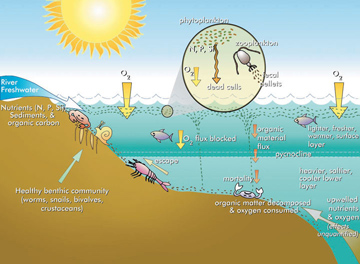Every year, large “dead zones” form in the Gulf of Mexico off the coasts of Texas and Louisiana. They form when river water loaded with fertilizer and other nutrients gushes into the Gulf. The nutrients spawn a massive “bloom” of microscopic organisms that use up much of the water’s oxygen. That kills fish and shellfish.
 Most of the runoff comes from the Mississippi River basin. But a recent study suggests that the mighty Mississippi isn’t always to blame.
Most of the runoff comes from the Mississippi River basin. But a recent study suggests that the mighty Mississippi isn’t always to blame.
Scientists at Texas A&M University studied an episode of unusually low oxygen levels off the Texas coast in the summer of 2007.
That was an especially wet season in parts of central Texas, so the only major Texas river that empties directly into the Gulf —the Brazos — was discharging far more water than usual. The researchers found that the river water formed a sort of “lid” atop the waters of the Gulf, the same way the Mississippi does in most years. That isolated water at the bottom, so it couldn’t mix with oxygen-rich waters at the surface.
The scientists confirmed that the Brazos was responsible for the event by measuring the ratio of different forms of oxygen in the fresher water atop the Gulf. Each river basin has a different oxygen “fingerprint,” so they were able to show that the Brazos River was responsible — and not the Mississippi.
Dead zones are becoming more common in all the world’s oceans. Studies like these can help isolate the causes —providing critical information for preventing future problems.
This episode of Science and the Sea was made possible by Texas Sea Grant

